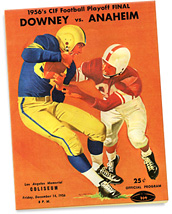 |
Lash's Place- Downey High News! |
| |
The
Golden Kingdom: Art Hansen |
 |
|
The Book "The Golden Kingdom" weaves together two epic stories that occurred in Southern California during the early Cold War Era encompassing the late 1940s through the mid-1960s. The first of these stories is focused upon the enormous popularity enjoyed by high school football within the Southland in these years, to the point where it was a key marker of civic pride and identity as well as being emblematic of the Southern California life style. The center-piece is a tale of two extraordinary high school football teams, the Downey High School Vikings and the Anaheim High School Colonists, during the 1956 season. Led by two fabled running backs, Randy Meadows of Downey and Mickey Flynn of Anaheim, these teams both went undefeated against their twelve respective opponents, which landed them on the turf of the Los Angeles Coliseum on December 13, 1956, to determine the championship of the southern section of the California Interscholastic Federation (CIF). The result was a 13-13 tie and a shared title. Featuring impressive touchdown runs by Meadows and Flynn this much heralded game was played before 41, 383 people, the largest crowd ever to view a high school football game in California. Meadows and Flynn were later named the co-Players of the Year for the CIF. If the first of the "heroic" stories examined in "The Golden Kingdom" serves as its "text" or sustaining narrative thread, the other epic story in the manuscript provides a social and cultural "context" to help readers fathom why the fortunes of high school football programs, as embodied and symbolized by the experience of the 1956 Anaheim Colonists and the Downey Vikings, assumed such potent significance, meaning, and value within early Cold War Southern California. In this connection, a searching exploration is made of such prominent developments in that era_frequently labeled a (or even the) "golden age" in American history_as general affluence and mass consumerism; dramatic demographic growth, pervasive suburbanization, and widespread home ownership; the rise of the defense industry, the predominance of a conservative political persuasion, and an emphasis upon "containment" in international relations and family life; and spiraling "automobility" and the upsurge of youth culture. Attention will also be paid to the importance of emergent challenges to this social and cultural consensus, as seen in shifting race, gender, and class relations, as well as the nascent opposition mounted against such powerful mainstream folkways as conformity, authority, and convention. The main challenge of "The Golden Kingdom" (whose title joins together two iconic American sites of popular culture associated with the cities of Downey and Anaheim, McDonalds and Disneyland) is to intertwine these two heroic stories into a comparatively seamless narrative, one whose contents are both accessible and appealing to a general and an academic audience alike. In addition to being grounded in standard documentary sources, "The Golden Kingdom" will be based on extensive tape-recorded oral histories with surviving early Cold War Southern California residents of the two communities (Downey and Anaheim) and football teams (Downey Vikings and Anaheim Colonists) showcased in this sports and society study. All of these audio-taped interviews will be transcribed, proofread and approved by the interviewees or narrators, and archived in the permanent collection of the Center for Oral and Public History at California State University, Fullerton, one of the largest university-based oral history archives in the United States.
The Author Art Hansen was born in 1938 in New Jersey. In 1949 his family moved to the Santa Barbara area in Southern California. A graduate of the Class of 1956 at Santa Barbara High School, where he lettered in varsity baseball, he was prevented from playing football by a series of knee operations. During his sophomore year, he witnessed the gridiron exploits of the Santa Barbara Dons and their spectacular triple-threat tailback, Ernie Zampese (who later played for the University of Southern California and for professional football teams in Canada and eventually became the offensive coordinator for four National Football League teams_the San Diego Chargers, the Los Angeles Ram, the Dallas Cowboys, and the New England Patriots). The Donsı 1953 season ended with a loss to Whittier High School in the semifinals of the southern section of the California Interscholastic Federation, which named Zampese as the Player of the Year. During Hansenıs senior year, he followed closely through the Los Angeles Times the heroics of Anaheim High Schoolıs junior halfback star, Mickey Flynn, who that year captured the same award as Zampese did two years earlier. Then, as a college freshman, Hansen monitored the 1956 football seasons of the Downey Vikings and the Anaheim Colonists, led by halfbacks Randy Meadows and Mickey Flynn. Although he did not see the legendary tied CIF championship game that season, he was among the 86,000 throng of fans who in the summer of 1957 were in attendance at the Los Angeles Coliseum to see the team of Southern California football stars get trounced by their Northern California counterparts in the annual Shrine All-Star Game. Now a professor emeritus of History at California State University, Fullerton (CSUF), where he has been since 1966, Art Hansen is the director of the Center for Oral and Public History. At CSUF he has taught mainly courses on the social-cultural-intellectual history of the United States, as well as Orange County history, community history, and oral history. In recent years he has taught graduate seminars on the topic of the Cold War culture and society in Southern California. His specialty field of historical research and publication is the World War II exclusion and detention experience of Americans of Japanese ancestry. In addition to his activities at Cal State Fullerton, Hansen has been a consultant at the Japanese American National Museum in Los Angeles, where he served as Senior Historian from 2001 through 2005. He is past president of the regional Southwest Oral History Association and the national Oral History Association and also edited the OHAıs scholarly journal, the Oral History Review, as well as co-editing the Journal of Orange County Studies. |